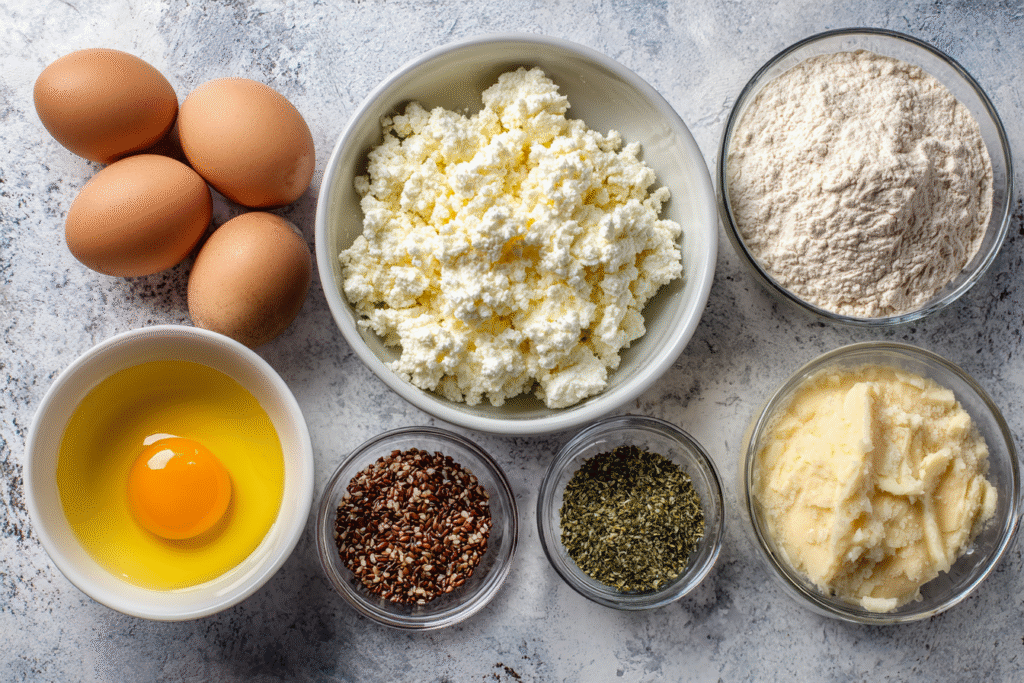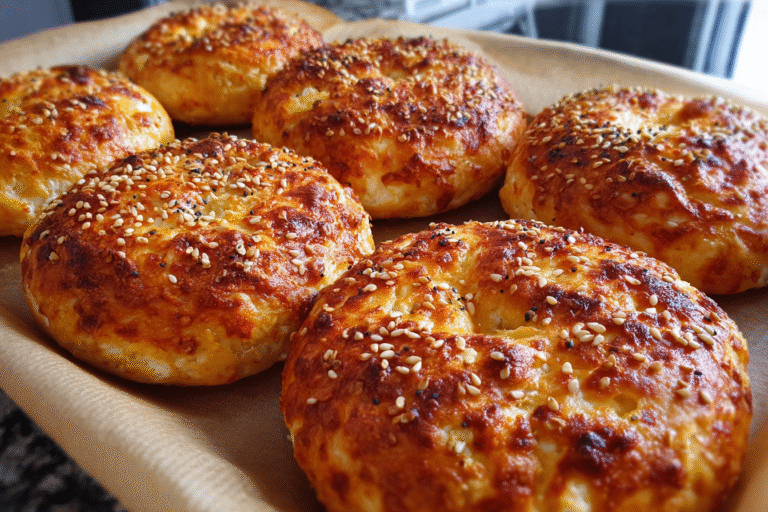If you’ve ever dreamed of a bagel that combines comfort, protein, and just the right crunch—you’re not alone. At Tasty Dwell, we’re constantly reinventing classic recipes for today’s health-conscious foodies. That’s how our cottage cheese bagels recipe was born. One weekend in our test kitchen, we wanted something simple yet macro-friendly—so we swapped traditional ingredients with full-fat cottage cheese, and voilà! The result? A chewy-on-the-outside, fluffy-on-the-inside bagel that’s as satisfying as it is nutritious.
This article dives deep into the world of homemade cottage cheese bagels: from the viral Bethenny Frankel-inspired recipe to whether cottage cheese really works as a yogurt substitute in baking. You’ll get ingredient insights, prep tips, health benefits, FAQs, and more. Plus, we’ve sprinkled in helpful links to our favorite high-protein bakes that’ll pair perfectly with your fresh bagels.
👉 Discover great ideas like our cottage cheese oatmeal cookies recipe to match your bagel experience.
Table of Contents
PART 1: Why Cottage Cheese is the Secret Star in These Bagels
The Nutritional Power of Cottage Cheese in Bagels
Cottage cheese isn’t just a creamy topping—it’s a secret weapon in baking.
Compared to Greek yogurt, cottage cheese has more fat and a gentler tang, giving bagels a chewier texture and fuller flavor.
1. Rich in casein protein and essential nutrients like calcium and vitamin B12, it adds density, structure, and richness to bagels.
2. It’s especially effective in recipes requiring moisture and binding, like these no-boil bagels. And let’s not forget—it has fewer carbs and more protein than traditional bread bases, making it ideal for fitness-focused food lovers.
Cottage Cheese vs. Yogurt: Which Makes Better Bagels?
It’s a common kitchen debate: Should you use cottage cheese or Greek yogurt in bagel dough? Greek yogurt brings tang and creaminess, but cottage cheese offers better moisture control, resulting in a tender bite. It also has a longer shelf life and provides a fluffier interior texture when blended well.
That said, both can work if paired with self-rising flour, but only cottage cheese helps deliver that golden crust when paired with an egg wash and toppings. If you want your bagel to mimic New York-style perfection with a health twist—go with cottage cheese.
PART 2: How to Make Cottage Cheese Bagels from Scratch
Ingredient Breakdown and Substitutions
The beauty of cottage cheese bagels lies in their minimal ingredient list. Here’s what you need:
| Ingredient | Amount | Notes |
|---|---|---|
| Self-rising flour | 1 cup | Contains baking powder and salt already |
| Full-fat cottage cheese | 1 cup | For richer taste and softer dough |
| Large egg (beaten) | 1 | Used for egg wash |
| Toppings | As desired | Try everything bagel seasoning, sesame seeds, asiago, or poppy seeds |

Optional substitutes:
- Greek yogurt can work if you don’t have cottage cheese, but you’ll get a tangier and slightly drier dough.
- Gluten-free self-rising flour is great for celiac-friendly bagels.
- Egg-free option: Use plant-based milk with a pinch of turmeric for color as a wash.
👉 Don’t miss our keto cottage cheese cookies recipe for another low-carb protein snack.
Step-by-Step Instructions for Perfect Texture
Step 1: Preheat and Prep
- Preheat your oven to 375°F (190°C). Line a baking sheet with parchment paper.
Step 2: Make the Dough
- In a large bowl, combine 1 cup of self-rising flour and 1 cup of full-fat cottage cheese.
- Mix until a rough dough forms, then knead on a floured surface for 3–5 minutes until smooth.
Step 3: Shape Your Bagels
- Divide the dough into 4 equal portions. Roll each into a log and pinch ends together to form rings.
Step 4: Add the Egg Wash and Toppings
- Place bagels on the baking sheet. Brush with beaten egg and sprinkle your toppings.
Step 5: Bake
- Bake for 25 to 30 minutes, or until the tops are golden and feel firm. Allow them to cool for 10 minutes before serving.
🎯 Pro Tip: For a crispier crust, broil for 2 extra minutes at the end.
PART 3: Customizing Your Cottage Cheese Bagels
Flavorful Topping Ideas to Upgrade Your Bagels
Toppings transform a simple bagel into something gourmet. Here are some crowd favorites and healthy options:
- Everything Bagel Seasoning – Salty, crunchy, aromatic
- Sesame + Asiago Combo – Nutty meets cheesy for a savory hit
- Garlic flakes + dried herbs – Mediterranean vibes
- Cinnamon and erythritol – For a sweet version without sugar
Pair your bagels with savory spreads like hummus, avocado mash, or even cottage cheese oatmeal raisin cookies for a brunch spread.
Nutrition-Packed Add-Ins for High-Protein Goals
Cottage cheese bagels are already protein-rich, but you can elevate them even further:
- Chia seeds or flaxseed – Boost fiber and omega-3s
- Unflavored whey or collagen powder – Stir in a tablespoon for an extra protein punch
- Shredded zucchini or carrots – Adds texture and vitamins with minimal flavor change
- Fresh herbs – Dill, chives, or basil mixed into the dough give it a fresh twist
💡 Looking for inspiration? Try our cottage cheese keto chocolate chip cookies to create a complete high-protein breakfast spread.
PART 4: Health Benefits of Cottage Cheese Bagels
High Protein, Low Guilt: The Macros That Matter
Cottage cheese bagels are a game-changer for anyone looking to cut back on refined carbs without sacrificing satisfaction. Here’s a quick macro breakdown for one bagel (based on the base recipe):
| Nutrient | Approx. Amount |
|---|---|
| Calories | 160–180 kcal |
| Protein | 12–15g |
| Carbohydrates | 18–22g |
| Fat | 4–6g |
| Sugar | < 2g |
That’s nearly double the protein of a traditional store-bought bagel and half the carbs. Plus, cottage cheese is loaded with casein protein, which is slow-digesting—making these bagels perfect for sustained energy.
💪 Don’t miss our article on cottage cheese banana chocolate chip cookies for another macro-friendly recipe.
Digestive and Bone Health Benefits
Cottage cheese is a great source of calcium, phosphorus, and probiotics (when cultured), all important for strong bones and a healthy digestive system. Combined with self-rising flour, which includes baking powder (a sodium bicarbonate source), these bagels can even help neutralize stomach acid in sensitive individuals.
They’re also naturally lower in lactose than milk, making them easier to digest for many people who are mildly lactose intolerant.
PART 5: Why Bodybuilders and Athletes Love Cottage Cheese
Casein Protein and Muscle Recovery
So, why do bodybuilders eat cottage cheese before bed? It’s all about casein, the slow-digesting protein that helps maintain a steady release of amino acids overnight. Unlike whey, which absorbs quickly, casein provides your muscles with fuel while you sleep, reducing overnight muscle breakdown.
When incorporated into bagels, it creates a high-protein, slow-carb combo—ideal for post-workout or late-night snacks. Add peanut butter on top, and you’ve got a full amino acid profile for muscle recovery.
🔥 Check out our cottage cheese chocolate chip cookies for another protein-packed treat loved by fitness folks.
Energy Without the Crash
These bagels provide sustained energy without the insulin spike of refined white flour options. The balance of protein, fat, and slow-digesting carbs makes them perfect for:
- Pre-workout fuel
- Midday snacks
- Long workdays without a crash
They’re especially helpful for endurance athletes who need long-term satiety and consistent energy.
PART 6: Bethenny Frankel’s Viral Cottage Cheese Bagel Recipe—Explained
Breaking Down the 2-Ingredient Trend
Bethenny Frankel made waves when she shared her version of cottage cheese bagels with just two ingredients: self-rising flour and cottage cheese. Her take sparked millions of views—and for good reason.
Her version:
- No yeast, no boiling
- Done in under 30 minutes
- Crispy outside, chewy inside
This simple combo delivers bakery-style results using everyday ingredients. By skipping yeast, you avoid long rise times but still get a beautiful texture thanks to the moisture and fat in cottage cheese.
How Our Recipe Adds an Upgrade
While Bethenny’s method is quick and effective, we kick it up a notch at Tasty Dwell by:
- Adding an egg wash for golden color
- Recommending creative toppings for variety
- Suggesting custom add-ins for flavor and function
- Including nutrition insights so it fits any meal plan
Our version builds on the viral trend but offers versatility and real balance—whether you’re a weekend baker or a performance-focused foodie.
🧁 Want more creative uses for cottage cheese? Try our cottage cheese blueberry cookies.
PART 7: Cottage Cheese Bagels FAQs – Answered
Is Cottage Cheese Good for Bagels?
Absolutely. Cottage cheese is not only good—it’s ideal. It adds:
- Moisture and tenderness to the dough
- A rich, slightly tangy flavor
- High protein content to support satiety and muscle repair
It works especially well in recipes that don’t rely on yeast or boiling, making it a shortcut to a perfect soft interior and crisp exterior.
Can You Use Cottage Cheese Instead of Yogurt in Bagels?
Yes, you can. Cottage cheese makes a great substitute for yogurt in most 2-ingredient doughs. Here’s a quick comparison:
| Feature | Cottage Cheese | Greek Yogurt |
|---|---|---|
| Texture | Slightly thicker, curdy | Smooth, creamy |
| Protein | Higher in casein | Higher in whey |
| Taste | Milder | Tangier |
| Moisture | More forgiving | Drier when overbaked |
Cottage cheese may require a quick blend to smooth it out, but it holds up better in baking without over-drying.
How Do You Make Bethenny Frankel’s Viral Cottage Cheese Bagel?
Bethenny’s recipe is as simple as:
- Mix equal parts self-rising flour and cottage cheese
- Shape into bagels
- Bake at 375°F for 25–30 minutes
We enhance her base with a golden egg wash, creative toppings, and flavor add-ins. This helps add color, flavor, and structure for next-level results.
Why Do Bodybuilders Eat Cottage Cheese Before Bed?
Cottage cheese is high in casein protein, which digests slowly and provides a steady release of energy over several hours. This helps:
- Prevent overnight muscle breakdown
- Support steady muscle recovery
- Provide satiety during fasting periods
When turned into a bagel, it becomes a carb-protein hybrid that’s even more satisfying.
PART 8: Expert Tips to Perfect Every Bake
Avoid These Common Mistakes
Even with just a few ingredients, it’s easy to slip up. Here are common pitfalls:
- Not draining watery cottage cheese can result in too much moisture, making the dough sticky and hard to work with.
- Over-flouring the surface – This can dry out your bagels
- Skipping the egg wash – You’ll miss out on that golden, bakery-style crust
- Using low-fat cottage cheese – Leads to rubbery texture; stick with full-fat
Baker’s Tips for Perfect Bagel Texture
- Use a spatula to combine first, then knead lightly
- Let the dough rest 5 minutes before shaping for easier handling
- Bake on the middle rack to avoid undercooked centers
- Add a small ice cube to the oven for steam (chewier crust)
🎯 Pro Tip: If your bagels look pale, broil the last 2 minutes!
PART 9: How to Store and Reheat Cottage Cheese Bagels
Storing for Freshness
Cottage cheese bagels stay fresh longer than most thanks to their high moisture content. Still, proper storage is key:
| Storage Method | Duration | Notes |
|---|---|---|
| Room Temp (airtight) | 2 days | Best for immediate use |
| Refrigerator | 5–6 days | Reheat before eating |
| Freezer (wrapped) | 2 months | Wrap in plastic, then foil or zip bag |
Reheating Without Losing Texture
- Oven: 350°F for 5–7 minutes for a crispy crust
- Toaster: Perfect for split bagels
- Microwave: 20–25 seconds wrapped in a damp paper towel if you prefer soft
Avoid overheating—cottage cheese-based bakes dry out quicker than yeast-based ones.
💡 Bonus: Toast and top with almond butter, eggs, or even leftover cottage cheese chocolate chip cookie dough for a gourmet treat.
Frequently Asked Questions About Cottage Cheese Bagels
Is cottage cheese good for bagels?
Yes. Cottage cheese provides moisture, protein, and a mild tang that enriches the dough’s flavor and texture. It also results in a chewy, bakery-style bagel with fewer carbs and more protein than traditional recipes.
Can you use cottage cheese instead of yogurt in bagels?
Definitely. Cottage cheese is a protein-rich alternative to Greek yogurt. It gives a similar rise but results in a moister and more tender texture. Blend it for a smoother consistency if needed.
How do you make Bethenny Frankel’s viral cottage cheese bagel?
Bethenny’s version is a 2-ingredient wonder: self-rising flour and cottage cheese. Mix, shape, and bake at 375°F for 25–30 minutes. We add egg wash and toppings to elevate the experience.
Why do bodybuilders eat cottage cheese before bed?
Bodybuilders eat cottage cheese before bed due to its high casein protein content. This slow-digesting protein supports overnight muscle recovery and helps maintain lean mass during rest.
For more recipes, follow me on Facebook and Pinterest!

Cottage Cheese Bagels: The High-Protein Breakfast You Didn’t Know You Needed
These 2-ingredient Cottage Cheese Bagels are a high-protein, no-yeast twist on the classic breakfast staple. Made with just cottage cheese and self-rising flour, they’re soft inside, crisp outside, and ready in 30 minutes. Top with everything seasoning, sesame seeds, or cheese for an easy, healthy meal any time of day.
- Total Time: 40 minutes
- Yield: 4 bagels
Ingredients
- 1 cup self-rising flour
- 1 cup full-fat cottage cheese
- 1 large egg, beaten (for egg wash)
- Toppings of choice: everything bagel seasoning, sesame seeds, shredded asiago cheese, or poppy seeds
Instructions
- Preheat and Prep: Preheat your oven to 375°F (190°C) and line a baking sheet with parchment paper.
- Make the Dough: In a large bowl, mix self-rising flour and cottage cheese until a dough forms. Knead briefly on a floured surface until smooth.
- Shape: Divide the dough into 4 equal pieces. Roll each into a log and pinch ends together to form a bagel shape.
- Top and Bake: Transfer to the baking sheet, brush with egg wash, and add desired toppings. Bake for 25–30 minutes until golden brown.
- Cool and Serve: Let bagels cool for 10 minutes before slicing. Enjoy warm or toasted!
Notes
For a smoother dough, blend cottage cheese briefly before mixing. Full-fat cottage cheese yields better texture. Add shredded herbs, garlic powder, or cheese inside the dough for flavor variations. Store in the fridge for 5 days or freeze up to 2 months.
- Prep Time: 10 minutes
- Cook Time: 30 minutes
- Category: Breakfast
- Method: Baking
- Cuisine: American
- Diet: Vegetarian

